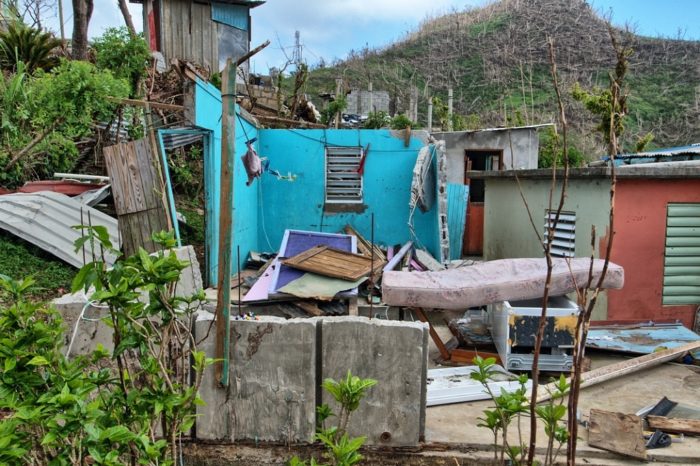Author(s): Melanie Kappes, DRM Specialist, World Bank and Anna-Maria Bogdanova, Operations Officer, GFDRR
In 2017, two Category 5 hurricanes – Hurricanes Irma and Maria – hit the Caribbean and devastated several countries including Dominica, Puerto Rico, Antigua and Barbuda and Sint Maarten. Only in Dominica this resulted in damages and losses of about US$ 1,311 million, an equivalent of 226% of the island’s 2016 gross domestic product (GDP). With high levels of certainty, we can assume that with climate change intensity and frequency of such extreme events will even increase in the future.

While investments in risk reduction and adaptation are critical to increase physical resilience in the region, there will always remain significant risk to vulnerable population of loss of life, livelihoods and assets. But we also know that thanks to high quality forecasts, and strong progress in delivering warnings to the community, and then translating those warnings into preventative actions, many lives can be saved, and potential economic losses reduced. In the Caribbean, without the strong performance of hurricane track forecasting and early warning systems (EWS), the death toll may have been far worse. In Anguilla, in anticipation of Hurricane Irma, the government issued warnings, advised mariners to stay in port and seek safe anchorage, schools and government offices were closed, and shelters were opened. In Antigua and Barbuda, drains were cleaned in preparation for heavy rains expected upon landfall of the hurricane. And in the Dominican Republic, due to warnings and evacuation more than 3,000 people were safely in shelters when Irma hit.

These are just a few examples to demonstrate that early warning systems are so much more than a measuring device and a siren. In reality, effective EWS are complex systems that play critical role in providing timely information for informed decision-making and actions. In order to achieve this vision, the people the EWS shall serve need to be at the center of it. This requires the coordination of a multitude of actors and actions, including the modelers to understand risk and collect climate information (see graphic – red circle); meteorologists and hydrologists that monitor and forecast hurricanes and other hydrometeorological phenomena (orange circle), the emergency management and communication agencies for efficient transmission of information (blue circle), and the community liaisons and organizations as well as the community itself to prepare for emergencies with capacity building, plans and evacuation, protocols and drills, as well as to take adequate action when the time comes (green circle). Thereby, effective communication across all aspects and actors before, during and after an event is the critical factor for efficiency and sustainability of any EWS.
Another important aspect is the preparation and continuous strengthening of the system that is required. The most successful cases show that it takes years to build an EWS and make it work as a well-oiled machine when an extreme event takes place. Most recently, Cyclone Fani slammed into Odisha, an eastern Indian state on the Bay of Bengal. Less then 20 lives were lost while over a million people were evacuated in an efficient manner from their mud-and-stick shacks to safe shelters during the storm. According to Odisha’s authorities, it was not the work of a day or a month but 20 years of building and improving the EWS and response mechanisms – work done since a disastrous storm in 1999 when thousands had been killed.
The Caribbean is embarking on a process to further strengthen their EWS the development of a regional strategy to coordinate and address key shortcomings and streamline efforts. With its 13 independent countries and many overseas territories, it is a heterogeneous region facing both challenges and great potential at the same time. Some challenges fall on the smaller countries with less than 200,000 inhabitants who often struggle with limited financial and human resources. However, great opportunities lie in complementing national-level capacities through regional-level collaboration and support structures. Furthermore, regional centers and organizations such as the Caribbean Disaster Emergency Management Agency (CDEMA) and the Caribbean Institute for Meteorology and Hydrology (CIMH) have greater capability and the mandate to support national services and early warning systems, and their role increases, especially in the cases similar to the recent hurricanes. By further strengthening this complex system and its collaboration and coordination mechanisms, countries will enhance decision-making during severe events and increase resilience in the region.
During the session “End-to-End Early Warning Systems – what does it take to avoid a disaster” at the Understanding Risk (UR) Caribbean Conference in Barbados, participants across ministries will have the chance to explore the challenges of efficient communication and quick action through a role play in which a storm is quickly approaching a fictional island and threatening its population. Subsequently, the group will identify and discuss key challenges and avenues of opportunity to strengthen early warning systems in the region. We are looking forward to seeing you there!
